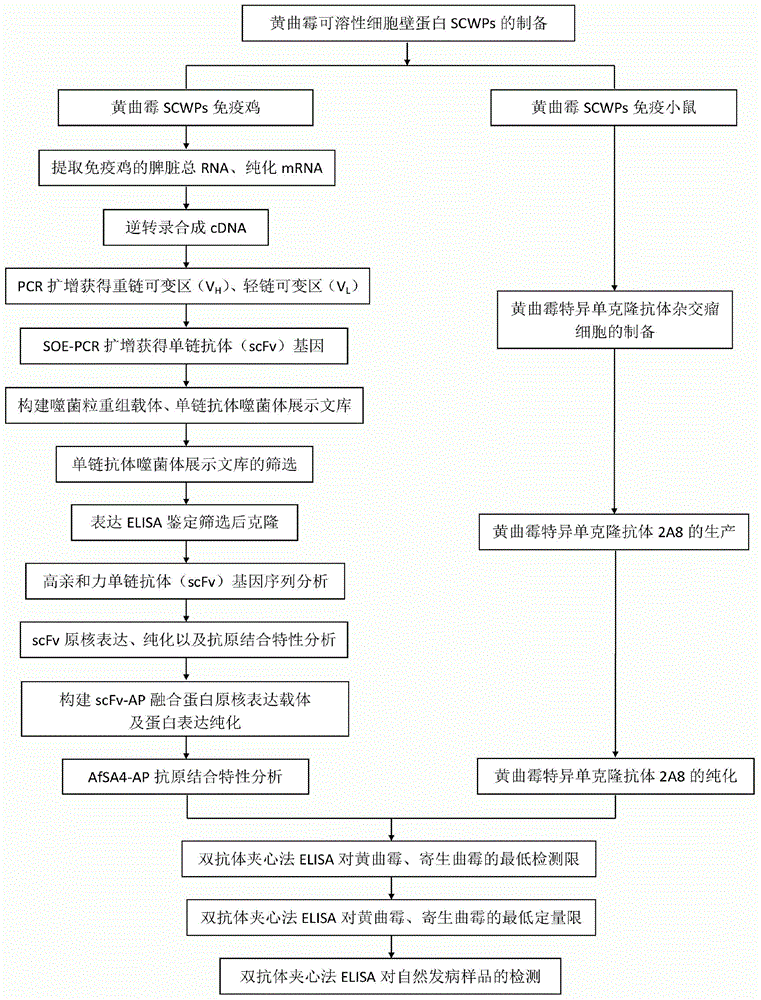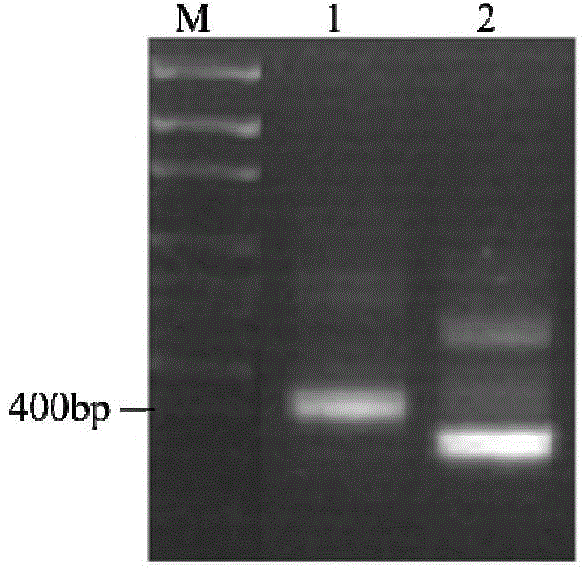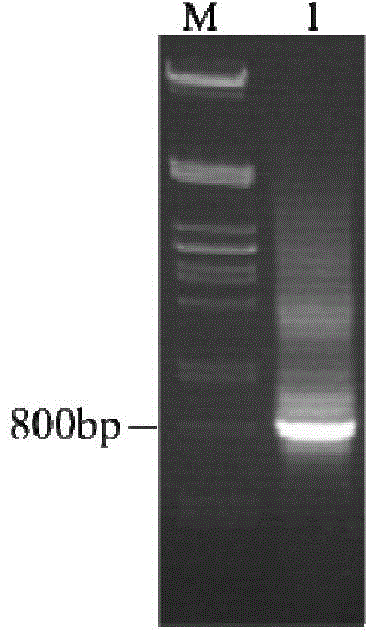Preparation method and application of aspergillus flavus specific single-chain antibody
A technology of single-chain antibody and Aspergillus flavus, which is applied in the fields of botanical equipment and methods, microorganism-based methods, biochemical equipment and methods, etc., and can solve the problems of decreased antibody specificity and affinity, and increased production costs
- Summary
- Abstract
- Description
- Claims
- Application Information
AI Technical Summary
Problems solved by technology
Method used
Image
Examples
Embodiment 1
[0081] Example 1: Preparation of Aspergillus flavus cell wall proteins (SCWPs)
[0082] 1) Use a sterilized toothpick to pick the Aspergillus flavus strain wh-1 (collected from Hubei, Wuhan, China). The strain was morphologically identified as Aspergillus flavus, and its ability to produce aflatoxin was determined by LC-MS / MS Determination (Han Z, Ren Y, et a1. J. Agric. Food Chem. 2012, 60, 8233-8247), AFB 8 days after inoculation of peanut l And AFB 2 The contents were 775.39μg / kg and 26μg / kg; AFB 8 days after inoculation with corn l And AFB 2 The contents are 1056.8μg / kg and 55.04μg / kg), inoculated into PDA medium (composition: 20% (W / V) potato, 2% (W / V) glucose, 1.5% (W / V) agar) Cultivate at 28°C for 5 days, wash the conidia on the surface of the hypha with sterile water containing 0.05% Tween-20, and collect the spore liquid.
[0083] 2) Take 1ml (1×10 5 / M1) Inoculated in 160ml Czapek medium (composition: 3% (W / V) sucrose, 0.3% (W / V) NaNO 3 , 0.1%(W / V)K 2 HPO 4 ,0.05%(W / V)MgS...
Embodiment 2
[0103] Example 2: Immunization of hens with SCWPs
[0104] Laiheng hens (purchased from the chicken farm of Huazhong Agricultural University) were immunized with the prepared Aspergillus flavus SCWPs for 6 times, and the immunization method was intramuscular injection every 14 days. For the first time, 500 μl (200 μg) of SCWPs prepared in Example 1 were used as the antigen and mixed with 500 μl Freund's complete adjuvant for immunization, and the second to fifth booster immunizations: 500 μl antigen and 500 μl of Freund's incomplete adjuvant were mixed and immunized. One week after the third and fifth immunizations, blood was taken intravenously, and the serum was diluted 1:200 times, and the antibody titer in chicken serum was detected by indirect ELISA (refer to Lin Qiaoai, Dong Haiyan, editors, "Medical Immunology and Microbiology" Guidance for Learning Experiments, Zhejiang University Press, 2006). The results showed that the titer of the Aspergillus flavus-specific antibody...
Embodiment 3
[0105] Example 3: Extraction of total RNA from chicken spleen, purification of mRNA and synthesis of the first strand of cDNA
[0106] 1) Seven days after the last immunization, the spleen of the chicken with the highest antibody titer was taken, and the spleen cells were separated.
[0107] 2) Extract total RNA from chicken spleen using TRIzol total RNA extraction reagent (purchased from Invitrogen, operated in accordance with the instructions).
[0108] 3) Purify mRNA from the total RNA extracted in step 2) using an mRNA purification kit (purchased from QIAGEN, operated according to the instructions).
[0109] 4) Use SuperScript TM III Reverse Transcription Kit (purchased from Invitrogen, operated according to the instructions), using the mRNA obtained in step 3) as a template, using the primer oligo(dT) 12-18 (Commercial primers purchased from Invitrogen) Synthesize the first strand of cDNA.
PUM
 Login to View More
Login to View More Abstract
Description
Claims
Application Information
 Login to View More
Login to View More - R&D
- Intellectual Property
- Life Sciences
- Materials
- Tech Scout
- Unparalleled Data Quality
- Higher Quality Content
- 60% Fewer Hallucinations
Browse by: Latest US Patents, China's latest patents, Technical Efficacy Thesaurus, Application Domain, Technology Topic, Popular Technical Reports.
© 2025 PatSnap. All rights reserved.Legal|Privacy policy|Modern Slavery Act Transparency Statement|Sitemap|About US| Contact US: help@patsnap.com



